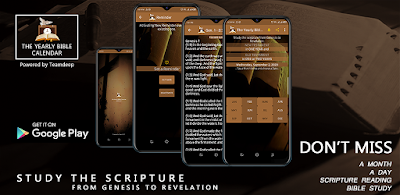Today’s Bible Reading
November 24
Old Testament I
2 Chronicles 21, 22
2 Chronicles 21 and 22 record the reigns of two kings of Judah: Jehoram and Ahaziah.
In chapter 21, we learn that Jehoram, the eldest son of Jehoshaphat, became king of Judah after his father's death. Unlike his father, Jehoram was an evil king who followed the ways of the kings of Israel and worshiped false gods. He killed all of his brothers and some of the princes of Israel to secure his throne.
God was angry with Jehoram for his wickedness, and he sent a letter to him through the prophet Elijah, warning him of his impending doom. Jehoram did not listen to the prophet and continued in his evil ways. As a result, he was struck with a disease that caused his bowels to come out, and he died in great pain.
In chapter 22, we learn that Ahaziah, Jehoram's youngest son, became king of Judah after his father's death. He also followed the ways of the kings of Israel and worshiped false gods. He allied himself with King Joram of Israel to fight against the king of Aram, but he was wounded in the battle and returned to Jerusalem to die.
Ahaziah's mother, Athaliah, then took the throne and killed all of her grandchildren, except for one, Joash, who was hidden by his aunt in the temple for six years. When Joash was seven years old, he was anointed king of Judah, and Athaliah was put to death.
Overall, these two chapters demonstrate the consequences of disobedience to God and the importance of faithfulness to His commands. Despite the wickedness of the kings, God remained faithful to His people and ensured that His plans and purposes were fulfilled.
Old Testament II
Ezekiel 40
Ezekiel 40 begins with the prophet being transported by the Spirit of God to a high mountain, where he sees a vision of a new temple. The chapter goes on to provide detailed measurements and descriptions of the temple and its various areas, including the outer wall, gates, courtyards, and inner sanctuary.
The chapter begins with the date of the vision, which is in the 25th year of the Babylonian exile of King Jehoiachin. The prophet is shown a man whose appearance is like bronze, holding a measuring reed, who proceeds to measure the various aspects of the temple. The outer wall is measured first, followed by the east gate, which has seven steps leading up to it. The gate chambers and vestibules are also measured.
Next, the prophet sees the inner courtyard, which has a pavement made of hewn stone and is surrounded by chambers for the priests to use. The chapter then describes the north and south gates of the inner courtyard, which are similar in design to the east gate. The measurements of the rooms for the priests and the location of the tables for sacrifice are also given.
The chapter concludes with a description of the inner sanctuary, which is called the Most Holy Place. The prophet sees the measurements of the walls and the doorways, as well as the wooden altar and the cherubim carved on the walls.
Overall, Ezekiel 40 provides a highly detailed vision of a new temple that is to be built in the future, with specific measurements and descriptions of the various areas within it. The vision emphasizes the importance of the temple as a place of worship and sacrifice, and as a central point for the people of God to gather and offer their devotion.
New Testament
John 17
John 17 is a prayer that Jesus offers to God the Father just before he is arrested and crucified. In this prayer, Jesus expresses his love and devotion to his Father and asks for his disciples to be protected and united.
The prayer can be divided into three main parts:
- Jesus prays for himself: In the first part of the prayer, Jesus asks God to glorify him so that he can glorify God. He acknowledges that his time on earth is coming to an end and that he has accomplished the work that God sent him to do.
- Jesus prays for his disciples: In the second part of the prayer, Jesus prays for his disciples, asking God to protect them from the evil one and to sanctify them in the truth. He prays that they may be one as he and the Father are one, so that the world may know that God sent him.
- Jesus prays for all believers: In the final part of the prayer, Jesus extends his prayer to include all future believers, asking that they may be one as well. He prays that they may experience the fullness of his joy and that they may be protected from the evil one.
Throughout the prayer, Jesus emphasizes the importance of unity among his followers and the power of their testimony to the world. He also expresses his deep love and intimate relationship with his Father, and his desire for his followers to experience the same.




0 Comments